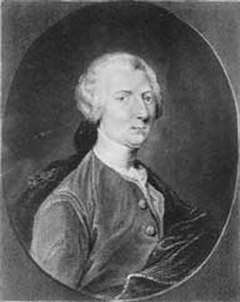Thomas Conway
Thomas Conway (February 27, 1735 – c. 1800) served as a major general in the American Continental Army during the American Revolutionary War. He became involved with the alleged Conway Cabal with Horatio Gates. He later served with Émigré forces during the French Revolutionary War.
 Thomas Conway (1735–1800) |
Early life
Conway was born in Ireland to James Conway and his wife Julieanne Conway.[1] Though born to a Catholic family, it is unclear how closely he adhered to the faith.[2][3] As a child, he immigrated to France with his parents. At 14, he enrolled in the Irish Brigade of the French Army and rose rapidly to colonel by 1772.[4]
Arrival in America
Following the outbreak of the American Revolutionary War he volunteered to the Congress for service with the American rebels in 1777. Based on an introduction from Silas Deane, the Congress appointed him a brigadier general on May 13, and sent him on to George Washington.
Conway commanded the leading brigade on the American right flank at the Battle of Germantown, and was justly praised for his actions. However, Washington opposed his promotion to major general, believing that many American-born officers with longer and valuable service deserved the rank; this caused a falling out between Washington and Conway. Congress appointed Conway a major general despite Washington's objections in December 1777, and made him inspector general of the army.
Conway Cabal
When his name was used politically, it was used to describe the infighting known as the Conway Cabal. During the affair, he had written a letter to General Horatio Gates in which he referred to Washington as a "weak general," criticizing General Washington's failed tactics against British General William Howe.[5] The letter stated: "Heaven has been determined to save your country; or a weak general [George Washington] and bad counselors would have ruined it."[6] The letter was intercepted by Washington and his backers after its delivery was botched by Brigadier General James Wilkinson, and brought before the Congress for inquiry. When the contents of the letter were made public, Conway lost his command as a result. He tried a ploy that had worked before his promotion, and submitted his resignation to Congress in March 1778. This time it was accepted, so he was forced to leave the continental army. John Cadwalader shot him in a duel on July 4, 1778.[7] When he recovered, he wrote an apology to Washington and returned to France.
There is also a slightly different version of these happenings:
He was challenged to a duel by Washington's friend, Gen. Cadwallader, who proceeded to shoot him through the mouth. Conway, believing himself dying, wrote one more letter. This time to Washington, asking forgiveness for his villainies and declaring the chief to be a "great and good man." Then he "conditionally" resigned his commission as an officer in the American service. Congress accepted the resignation, unconditionally, and Conway went back to France.[8]
Later life
Conway later returned to the French Army, in 1787 he received promotion to Maréchal-de-camp (Major General) and an appointment as Governor of French colonies in India.
In 1793 he fought with royalist forces in opposition to French Revolution in southern France.
During the French Revolution he was condemned to death. He was saved only by an appeal to Great Britain (against which he had fought in the American Revolution), but was compelled to flee from France for his life.[8]
After that Conway disappeared from history. He is supposed to have died about 1800 in Ireland with a loving wife and children.
References
- "James Conway (Count Conway) Biography". 27 March 2016. Retrieved 8 August 2016.
- "Conway of "The Cabal" and Charles Carroll of Carrollton, Concerning Washington". The American Catholic Historical Researches. M.I.J. Griffin. 22: 8–9. 1905. Retrieved 24 July 2019.
- Axelrod, Alan (1999). The Complete Idiot's Guide to the American Revolution. Penguin. p. 236. ISBN 9780028633794. Retrieved 24 July 2019.
- Fredriksen, John C. (2006). Revolutionary War Almanac. Infobase Publishing. p. 769. ISBN 9780816074686.
- Buescher, John and Ron Martin. "Dissent in the Ranks." Teachinghistory.org. Accessed 30 June 2011.
- Nathaniel Philbrick, "Valiant Ambition: George Washington, Benedict Arnold and the Fate of the American Revolution," (New York: Penguin Books, 2016), p. 180
- "John Thaxter to Abigail Adams". Founders Online. National Archives. 6 July 1778.
In the morning of the same day a duel was fought between Major Genl. Conway and Brigr. Cadwallader of Pennsylvania, the former of whom received a wound—the ball entered his Cheek and coming out under his Ear lodged in his hair. He is like to recover. There are so many reports respecting the origin of it that I cannot determine absolutely what did occasion it.
- The Gettysburg Times (Gettysburg, Pennsylvania) Jun 27, 1912
| Government offices | ||
|---|---|---|
| Preceded by David Charpentier de Cossigny |
Gouverneur Général de l'Inde française October 1787–1789 |
Succeeded by Camille Charles Leclerc, chevalier de Fresne |
| Military offices | ||
| Preceded by Augustin de La Balme Inspector General of Cavalry Philippe Charles Tronson de Coudray Inspector General of Ordnance and Military Stores |
Inspector General of the U.S. Army December 13, 1777-April 28, 1778 |
Succeeded by Friedrich Wilhelm von Steuben |